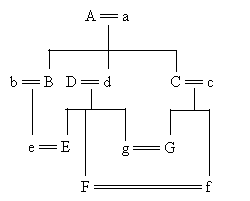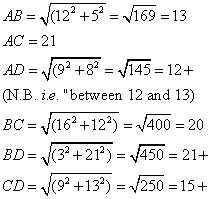

A Tangled Tale: Answer to Knot II
More Lessons for Math Trivia
Math Worksheets
A Tangled Tale - Questions for Knot 2
Question 1:
Answer: One.

Solution:
In this genealogy, males are denoted by capitals, and females by small letters.
The Governor is E and his guest is C.
Lewis Carroll's replies to correspondents:
Ten answers have been received. Of these, one is wrong, Galanthus Nivalis Major, who insists on inviting two guests, one being the Governor’s wife’s brother’s father. If she had taken his sister’s husband’s father instead, she would have found it possible to reduce the guests to one.
Of the nine who send right answers, Sea-Breeze is the very faintest breath that ever bore the name! She simply states that the Governor’s uncle might fulfill all the conditions “by intermarriages”! “Wind of the western sea”, you have had a very narrow escape! Be thankful to appear in the Class List at all! Bog-Oak and Bradshaw of the Future use genealogies which require 16 people instead of 14, by inviting the Governor’s father’s sister’s husband instead of his father’s wife’s brother. I cannot think this so good a solution as one that requires only 14. Caius and Valentine deserve special mention as the only two who have supplied genealogies.
Class List.
1 st place: Bee, Matthew Matticks, Caius, Old Cat, M. M, Valentine.
2 nd place:: Bog-Oak, Bradshaw of the Future.
3 rd place: Sea-Breeze.
Question 2:
Answer: From No. 9.
Solution: Let A be No. 9, B No. 25, C No. 52, and D No. 73. Then:

Hence the sum of distances from A is between 46 and 47; from B, between 54 and 55; from C, between 56 and 57; from D, between 48 and 51. (Why not “between 48 and 49”? Make this out for yourselves.) Hence the sum is least for A.
Lewis Carroll's replies to correspondents:
Twenty-five solutions have been received. Of these, 15 must be marked “zero”, 5 are partly right, and 5 right. Of the 15, I may dismiss Alphabetical Phantom, Bog-Oak, Dinah Mite, Fifee, Galanthus Nivalis Major (I fear the cold spring has blighted our Snowdrop), Guy, H.M.S. Pinafore, Janet, and Valentine with the simple remark that they insist on the unfortunate lodgers keeping to the pavement. (I used the words “crossed to Number Seventy-three” for the special purpose of showing that short cuts were possible.) Sea-Breeze does the same, and adds that “the result would be the same” even if they crossed the Square, but gives no proof of this. M. M. draws a diagram, and says that No. 9 is the house, “as the diagram shows”. I cannot see how it does so. Old Cat assumes that the house must be No. 9 or No. 73. She does not explain how she estimates the distances. Bee’s arithmetic is faulty: she makes √169+√442+√130=741. (I suppose you mean √742, which would be a little nearer the truth. But roots cannot be added in this manner. Do you think √9 + √16 is 25, or even √25?) But Ayr’s state is more perilous still: she draws illogical conclusions with a frightful calmness. After pointing out (rightly) that AC is less than BD, she says, “therefore the nearest house to the other three must be A or C.” And again, after pointing out (rightly) that B and D are both within the half-square containing A, she says, “therefore” AB +AD must be less than BC + CD. (There is no logical force in either “therefore”. For the first, try Nos. 1, 21, 60, 70: this will make your premise true, and your conclusion false. Similarly, for the second, try Nos. 1, 30, 91, 71.)
Of the five partly right solutions, Rags and Tatters and Mad Hatter (who send one answer between them) make No. 25 6 units from the corner instead of 5. Cheam, E. R. D. L., and Meggy Potts leave openings at the corners of the square, which are not in the data: moreover Cheam gives values for the distances without any hint that they are only approximations. Crophi and Mophi make the bold and unfounded assumption that there were really 21 houses on each side, instead of 20 as stated by Balbus. “We may assume,” they add, “that the doors of Nos. 21, 42, 63, 84, are invisible from the centre of the Square”! What is there, I wonder, that Crophi and Mophi would not assume?
Of the five who are wholly right, I think Bradshaw of the Future, Caius, Clifton C., and Martreb deserve special praise for their full analytical solutions. Matthew Matticks picks out No. 9, and proves it to be the right house in two ways, very neatly and ingeniously, but why he picks it out does not appear. It is an excellent synthetical proof, but lacks the analysis which the other four supply.
Class List
1 st place: Bradshaw of the Future, Clifton C, Caius, Martreb.
2 nd place: Matthew Matticks.
3 rd place: Cheam, Meggy Potts, Crophi and Mophi, Rags and Tatters, E. R. D. L., Mad Hatter.
A remonstrance has reached me from Scrutator on the subject of Knot 1, which he declares was “no problem at all”. “Two questions”, he says, “are put. To solve one there is no data: the other answers itself.” As to the first point, Scrutator is mistaken; there are (not “is”) data sufficient to answer the question. As to the other, it is interesting to know that the question “answers itself”, and I am sure it does the question great credit: still I fear I cannot enter it on the list of winners, as this competition is only open to human beings.
Try out our new and fun Fraction Concoction Game.
Add and subtract fractions to make exciting fraction concoctions following a recipe. There are four levels of difficulty: Easy, medium, hard and insane. Practice the basics of fraction addition and subtraction or challenge yourself with the insane level.



We welcome your feedback, comments and questions about this site or page. Please submit your feedback or enquiries via our Feedback page.